Best 2 Row Suv for Car Seats 2018
MY18
VEHICLES
There are 7 categories of vehicles (click the link to go directly to the section you're interested in):
-
- Sedans
- Hatchbacks/wagons
- Minivans
- Pick-up Trucks
- 2-row SUV's
- 3-row SUV's
- All 2018 IIHS TSP & TSP+
- Hybrids, Electrics, Fuel Cells
- 3-row SUV's not tested by IIHS
SEDANS
HATCHBACKS/WAGONS
MINIVANS
PICK-UP TRUCKS
2-ROW SUV'S
3-ROW SUV'S
HYBRIDS & ELECTRICS & FUEL CELLS
ALL 2018 IIHS TSP & TSP+ (and those that missed out only because their head lights didn't earn a high enough rating)
LARGE 3-ROW SUV's NOT TESTED BY IIHS
We are constantly getting asked about the large 3-row SUVs and which ones we'd recommend for families. Honestly, we wouldn't recommend any of them… we'd suggest getting the 8-seater model of the Honda Odyssey or Chrysler Pacifica minivan (no, we don't get any kick backs from Honda or Chrysler… or any other manufacturer either).
IIHS does not crash test the large SUVs – so we frankly don't know how safe they are or are not. Vehicle manufacturers do know which of their vehicles IIHS is most likely to test, and the manufacturers work very hard to help ensure these vehicles earn a good rating from IIHS. This motivation may not be there as much for these large SUVs which are not tested.
Below are the 3 row SUVs that IIHS has not tested (and likely won't test). Keep in mind that if the vehicle you had in mind isn't on this list and isn't in the above charts, it likely was tested by IIHS and didn't do well enough in crash testing or front crash prevention technology to earn a high enough rating to make it into our buying guide.
- Buick Enclave/Chevrolet Traverse
- Cadillac Escalade / Chevrolet Suburban / Chevrolet Tahoe / GMC Yukon
- Ford Expedition / Lincoln Navigator
- Infiniti QX80 / Nissan Armada
- Land Rover Discovery
- Lexus GX / Toyota 4Runner
- Lexus LX / Toyota Land Cruiser
- Mercedes Benz GLS
- Tesla Model X
- Toyota Sequoia
If you're going for a large 3-row SUV that wasn't tested by IIHS , the 2018 Ford Expedition/Lincoln Navigator is the clear winner. Note that the Expedition & Navigator were completely redesigned for 2018 – and it was a fabulous redesign. Since the Expedition and Navigator are the same vehicle, we're going to simplify and just say the Expedition… but you'll know we mean the Navigator too.
Here's why we think the Ford Expedition/Lincoln Navigator are the best of the 3-row SUV's not tested by IIHS:
- There is a car seat safe tilting feature that allows you to access the 3rd row without disturbing a LATCH installed car seat in the 2nd row!!!! And this feature works for both 2D and 2P!!! With this tilting feature, you can have 3 car seats across the 2nd row AND get into the 3rd row just as easily as if there were no car seats in the 2nd row. The Suburban offers no such thing, which means that loading a Suburban with lots of car seats in the 2nd row quickly means that you have no 3rd row access except by climbing through the trunk, which is horribly undignified!
- The 3rd row in the Expedition is about 5 inches deeper than in the Suburban . How much of a difference does 5 inches make? A lot! 5 inches means you can put a rear-facing car seat (infant seat or convertible) in the 3rd row of the Expedition, but not in the Suburban. 5 inches also means that if you are forward-facing (child or adult) in the 3rd row your head is much safer as you are less likely to hit your head on the back of the 2nd row seat since it is 5 inches farther away. This is a big deal – as the head is the most likely part of the body to be injured in a crash, and the most likely cause for a head injury is hitting your head on something in the car (like the seat in front of you, the door frame, etc).
- There is an option for an extended wheelbase version – to give you the trunk space you'll need behind the 3rd row. The only other 3-row SUV to offer this extended wheelbase option is the Chevrolet Suburban/ Chevrolet Tahoe / Cadillac Escalade/ GMC Yukon (we'll refer to these as the Suburban – but these 4 are all the same vehicle)… but that's where the similarities end with the Expedition vs the Suburban.
- There are head restraints for all positions … unlike the Suburban which has no head restraints in 2C or 3C. Positions without a head restraint are not suitable for kids in backless boosters or adults due the risk for severe whiplash injuries.
- There are lower anchors in 5 of the 6 positions (only 3C is neglected)… unlike the Suburban which has no lower anchors in the 3rd row for a sad total of only 3 lower anchor positions in a vehicle with 6 seats in back.
- There are tether anchors in all 6 positions (ok, here's the only time the Suburban can compete – it too has 6 tether anchor positions).
A distant 2nd place would go to the Mercedes Benz GLS and Land Rover Discovery. The Nissan Armada/Infiniti QX80, Lexus GX/Toyota 4Runner, and Tesla Model X would tie for very last place, with the Cadillac Escalade/Chevrolet Suburban/Chevrolet Tahoe/GMC Yukon coming in near-last on our list of recommended vehicles for families with children in car seats. The Land Cruiser & Sequoia haven't been updated in more than a decade… and with safety technology changing as rapidly as it is, we'd recommend getting a car that has been redone more recently.
As with any vehicle, you need to make sure that you get the front crash prevention technology to help your family avoid getting in a crash in the first place. This technology is not standard equipment on the Expedition/Navigator – but is available for both vehicles (yes, the price will go up when you get this technology, but you don't want to skimp here!).
What's in the columns?
We've got lots of columns in our family vehicle buying guide spreadsheet and you'll want to understand what each column can tell you. Be sure to click on each of the column headers below and read carefully so you get the most out of our buying guide.
Vehicle
This includes the make & model of the vehicle as well as how many people the vehicle seats. We've included the driver in the seating capacity. For example, a 5 seater will accommodate 2 in the front seat (a driver & front passenger) and 3 people in the back seat.
Lots of SUVs and minivans have different seating options. For example, the Toyota Highlander is a 3-row SUV that has either 2 seats or 3 seats in the 2nd row. We've listed the Highlander twice - once as a 7 seater and once as an 8 seater. Why'd we list it twice? Much of the information we've compiled - like how many lower anchor & tether positions the vehicle has, or whether there is seat belt overlap, etc - is different in the 7 seater vs 8 seater model.
Therefore, pay careful attention to the seating capacity when looking at 3-row vehicles as you'll want to compare the differences to help you choose the right one for your family's needs.
There are a few sedans/hatchbacks that have unexpected seating capacity. For example, the Toyota Prius Prime & Toyota Mirai both only seat 4 (they only have 2 seats in back).
Back Seat Applicable To
The numbers in this column refer to model years: 16 means 2016, 17 means 2017, etc.
Because vehicles are redesigned every 5-10 years typically, much of the information in this table applies to more than one model year of a particular vehicle. While the safety ratings often change per year - as manufacturers make structural improvements to the vehicle's safety cage and computer technology gets better and faster - the back seat stays the same for several years between redesigns. If you are buying a used vehicle that is a few years old, you can use this table and find information on older vehicles by filtering this column for vehicles in the model year range that you are interested in.
The information in the following columns is applicable to the model years noted in the "back seat applicable to" column:
- Lower Anchor & Tether information
- LATCH (diagram)
- LAs Total
- TAs Total
- Tethers (pictures)
- Back Seat Design & Dimensions
- R2 seats & pictures
- R3 seats & pictures
- Recline
- HR (pictures)
- Bump at Bight
- SBO (Seat Belt Overlap)
- Rigid Buckles
- Booster in 2C & 3C
- 2C & 3C Width
- 2D-2P LA spacing
- HR: 2D/2P, 2C, 3D/3P, 3C
- Vehicle Size
- Weight
- Length, Width, Height
- Drive & Fuel
- AWD
- Fuel Types
- Hybrid availability
CSL Top Pick?
If you only need to have at most 2 of anything (child or adult) in the back seat and you never need to use the center seat, then any of these vehicles could meet your needs and you can ignore the CSL Top Pick category as it won't be relevant to your needs.
However, we know that many families either want or need to be able to fit 2-Together (meaning 2 car seats side-by-side, to leave enough room for an extra adult to sit comfortably in back) or 3-Across (meaning 3 car seats or boosters in one row) in their vehicle. Also, while you may only have one child when you get this new car, you may still have it when you add a 2nd (or 3rd) child to your family. Getting a vehicle that is as versatile as possible for both your current and future needs can save you a lot of hassle and money in the future.
Yes
Those that earned a YES in the "CSL Top Pick" column are those vehicles which meet all 4 of the above criteria regarding favorable set-up for fitting 2 side-by-side or potentially 3-across (no seat belt overlap, center seat is wide enough for a booster, there is a center head restraint, and the spacing between the innermost lower anchors is at least 15 inches).
Keep in mind that you'll still need to make wise choices when selecting car seats for 2-together and 3-across even in these "Yes" vehicles. The car seats we've featured in our "2-together, 3-across project" are more likely to give you the arrangement you want in your new vehicle.
Maybe
Those that earned a MAYBE in the "CSL Top Pick" column are those vehicles which aren't our first choice, but are far better than the vehicles in the no & absolute no categories.
To earn a MAYBE, a vehicle needs to fit a narrow booster in the center and have a center head restraint (2 of the 4 "versatility" features we look at).
However, the vehicle had some other design features that may make it harder to do 2-together or 3-across in it. A few examples:
It may have some seat belt overlap - but likely not a severe amount (otherwise it would be a No or Absolute No) and probably has flexible buckles to make it easier to work around the seat belt overlap.
It may have had a narrow spacing between the innermost lower anchors, meaning that it will be much harder to find seats narrow enough to fit 2-together or 3-across.
Keep in mind that you'll still need to make wise choices when selecting car seats for 2-together and 3-across even in these MAYBE vehicles. The car seats we've featured in our "2-together, 3-across project" are more likely to give you the arrangement you want in your new vehicle.
No
Those that earned a NO in the "CSL Top Pick" column are vehicles that will pose significant challenges to fitting 2-Together or 3-Across, but with the right combination of narrow seats and seating arrangements may accommodate your family's needs... but we'd strongly recommend thinking twice before selecting one of these vehicles.
To earn a NO, a vehicle needed to have some design features that will make it harder to do 2-together or 3-across. A few examples:
It has seat belt overlap and rigid buckles - making it likely that a car seat in one position may make it impossible to buckle the seat belt in the adjacent position.
It has a very narrow spacing between the innermost lower anchors, meaning that 2-Together or fitting an adult in between 2 car seats is likely impossible.
It has no head restraint in 2C. This means you can't put an adult or a kid in a backless booster in 2C... unless you want to suffer serious whiplash injuries.
It was not possible to put a narrow backless booster in the center.
You'll notice that vehicles in both the NO and ABSOLUTE NO categories often couldn't fit a booster in 2C. So, what distinguishes these vehicles? The NO vehicles will typically accommodate the base of a narrow infant seat in 2C while the ABSOLUTE NO vehicles won't even accommodate most infant seat bases in 2C (without it blocking the use of an adjacent seat). Narrow infant seat bases to try: Cybex Aton2, Chicco Fit2, Graco SnugRide SnugLock DLX/Elite/Platinum.
It may have had a narrow spacing between the innermost lower anchors, meaning that it will be much harder to find seats narrow enough to fit 2-together or 3-across.
You will need to make wise choices when selecting car seats for 2-together and 3-across in these NO vehicles. The car seats we've featured in our "2-together, 3-across project" are more likely to give you the arrangement you want in your new vehicle.
Absolute No
Those that earned an ABSOLUTENO in the "CSL Top Pick" column are vehicles that will almost never accommodate 2-Together (while allowing the empty seat to be used by an adult wearing a seat belt) or 3-Across.
If you only need to have at most 2 of anything (child or adult) in the back seat and you never need to use the center seat, then an ABSOLUTE NO vehicle will likely be fine.... but if you ever need 2-Together or 3-Across this is not the vehicle you are looking for.
To earn an ABSOLUTE NO, a vehicle needed to have some design features that will make it impossible in most cases to do 2-together or 3-across. A few examples:
There is severe seat belt overlap and rigid buckles - making it likely that a car seat in one position will make it impossible to buckle the seat belt in the adjacent position. This is the reason for most of the vehicles in this category earning their ABSOLUTE NO. In some cases, the buckles were flexible, but not flexible enough to move far enough out of the way due to the severe seat belt overlap. Example: The 2014-2018 Mitsubishi Outlander.
2C is so narrow as to not accommodate any car seats, boosters, or adult bottoms. Example: The 2016-2018 Toyota Prius - with a center measuring just 7 inches "wide".
There is a massive console in 2C that severely limits what can go there. Example: The 2016-2018 Chevrolet Volt.
2C's seat belt hardware is bulky and when using 2C's seat belt its own hardware blocks the use of the seat belt for an adjacent position. Example: The 2017-2018 Alfa Romeo Giulia. the center seat belIt has a very narrow spacing between the innermost lower anchors, meaning that 2-Together or fitting an adult in between 2 car seats is likely impossible.
2nd Row Captain's Chairs
We have an additional category called "2nd Row Captain's Chairs" for all the vehicles that have only 2 seats in the 2nd row. You obviously can't do 2-together or 3-across in the 2nd row of these vehicles. We didn't want to lump them together with the ABSOLUTE NO category - as they are very different - so decided they deserved their own category as they are distinct from the vehicles that have 3 seats in the 2nd row.
CSL Page
We've created individual pages for every vehicle on this list, and more!
A vehicle's specific page typically includes more information about that vehicle than what you see here in this chart. In addition, we often have information for older model year ranges for many vehicles (and are adding more all the time).
Please, make sure to visit the page for any vehicle that you are considering so you can learn as much about it as possible.
Base Price
This is the base price for the current model year.
Keep in mind that for vehicles where front crash prevention is optional equipment, not standard, the price you'll pay is going to be higher because you don't want to miss out on this important safety technology.
2018 IIHS
The IIHS columns tell you what rating the Insurance Institute for Highway Safety gave a vehicle for a particular model year. You'll see that we have columns for the past 4 years (2015-2018) included here so that in case you are considering a late-model used vehicle the information on this table can be helpful in your search.
Keep in mind that each year the criteria to earn a TSP or TSP+ get more and more stringent - all with the goal of pushing vehicle manufacturers to keep making their cars as safe as possible. Therefore, you may notice that a vehicle earned a TSP one year and the next didn't earn an award. The vehicle didn't get less safe from one year to the next. What did happen is that the vehicle wasn't able to meet the more stringent criteria the next year to earn a TSP.
Abbreviations you'll see in these IIHS columns:
- TSP = Top Safety Pick
- TSP+ = Top Safety Pick +
- SOFD = Small Overlap Frontal (Driver's side).
- The letter after SOFD (like SOFD-M, or SOFD-P) refers to the rating given to the vehicle in this particular crash test. G=Good, A=Acceptable, M=Marginal, P=Poor.
- SOFP = Small Overlap Frontal (Passenger side)
- The letter after SOFP (like SOFP-M, or SOFP-P) refers to the rating given to the vehicle in this particular crash test. G=Good, A=Acceptable, M=Marginal, P=Poor.
- FCP = Front Crash Prevention. IIHS rates the effectiveness of this technology - with basic being the lowest score, followed by advanced, and then superior being the best.
- INC = Incomplete (IIHS did some, but not all of the testing required for a vehicle to earn a TSP or TSP+)
- N = Vehicle did not qualify for a TSP or TSP+ because it either did not perform well in one or more crash tests or lacked effective front crash prevention technology.
- HL = Headlights. The letter after HL (like HL-M, or HL-P) refers to the rating given to the headlights. G=Good, A=Acceptable, M=Marginal, P=Poor.
- NT = Not Tested
- - = Vehicle was not made in this year
- * =We gave a star to 2018 model year vehicles that would have earned a TSP or TSP+, were it not for the fact that their headlights were poor or marginal, which starting in 2018 disqualified the vehicle from earning a TSP or TSP+. For vehicles with a star, you'll see the headlight rating as well and we also included information on the front crash prevention as well as SOFD & SOFP when available.
- Some of these 2018 vehicles were given a 2017 TSP award (if this confuses you that IIHS gives a 2017 award to a 2018 vehicle, we'll share with you that we too are confused by this!). You'll see these noted as "17 TSP".
LATCH
If you are not sure what LATCH even is... that's OK! But first, you need to click here and read about LATCH and then come back to this vehicle buying guide.
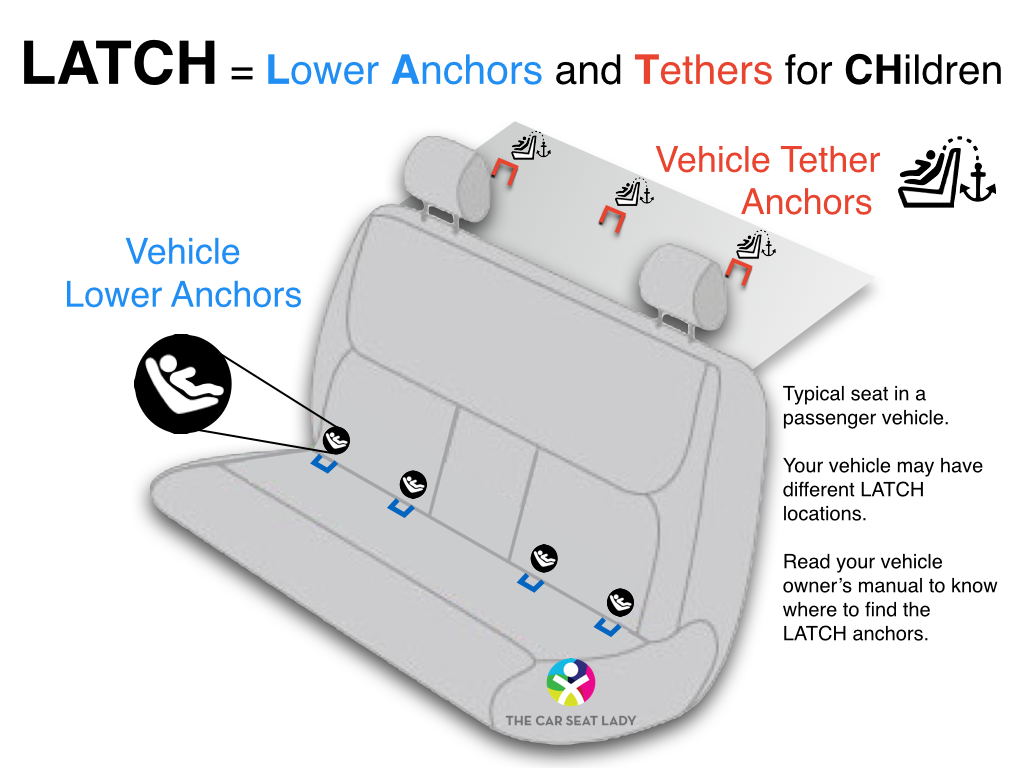
LATCH stands for Lower Anchors and Tethers for CHildren.
When we use the termLATCH, we are saying that there arebothlower anchors and a tether anchor for that seating position. This is an important distinction because some positions - like the center seat in most cars - have a tether anchor, but no lower anchors.
We've created images (samples shown below) to show you the layout of the vehicle and where you have tether anchors and lower anchors in that specific vehicle. 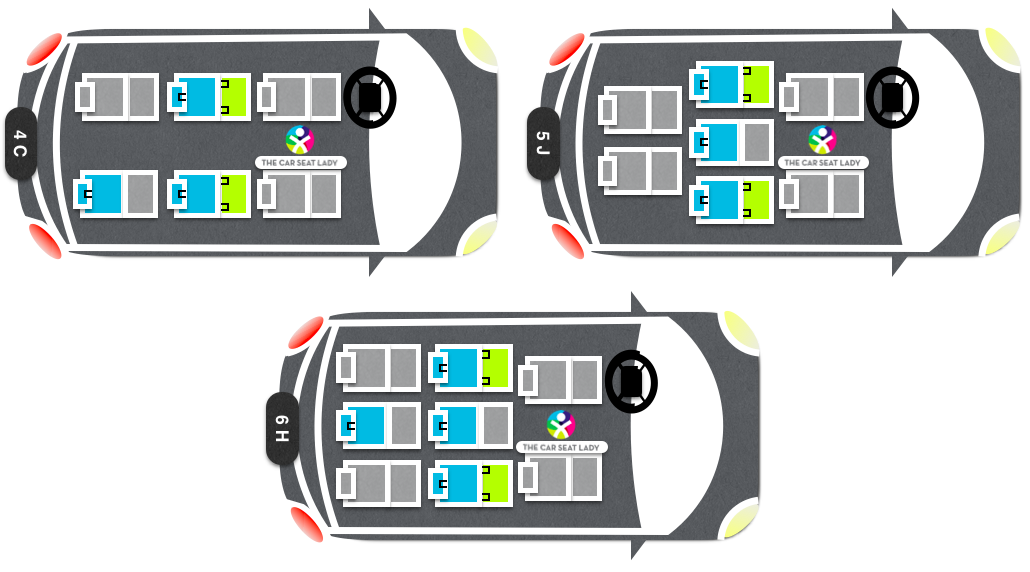

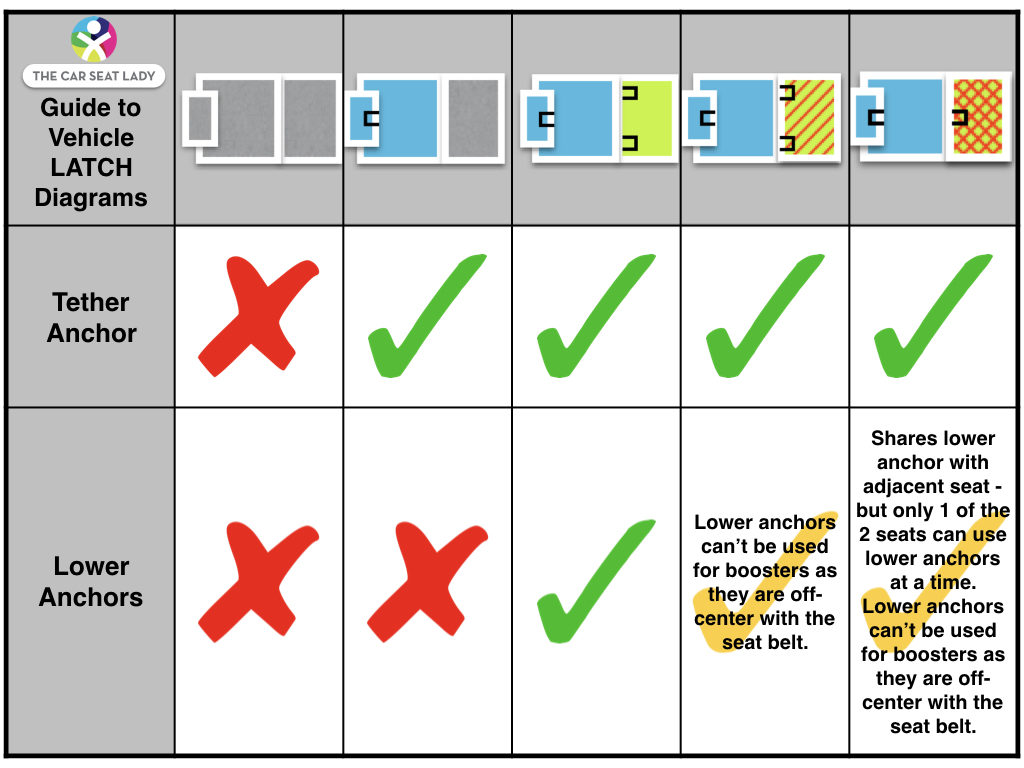
What does the letter and number on the vehicle's "license plate" mean?
To keep things organized, we've given each possible combination of lower anchors & tether anchors a number & letter (found on the license plate on the vehicle in the image). The number corresponds to how many seats there are in the back seat (the driver & front passenger are not included in this number). You can see in the picture above that vehicle 4C has 4 seats in back, 5J has 5, and 6H has 6 seats in back. The letter is just a way to distinguish all the possible variations.
For example, in the vehicles with 5 seats in back there are currently 25 different back seats (letters A to Y) in terms of where you will find lower anchors and tether anchors!
"Center LATCH": What about borrowing the innermost lower anchors (belonging to 2D & 2P) to install a car seat in 2C?
Less than 10% of vehicles allow this. Even in the vehicles that allow this, we did NOT count this borrowing as an additional lower anchor position as in most cases we find this type of center LATCH to be useless in the real world.
Why? In this scenario the spacing between the lower anchors you are using in 2C is typically much wider than the standard spacing of 11 inches, which means the lower anchor strap is stretching beyond 2C and into 2D & 2P, often crossing right over 2D & 2P's seat belt buckles and preventing them from being used. In many cases a car seat installed in 2C by borrowing the innermost lower anchors from 2D & 2P makes it such that the one car seat in 2C prevents anyone else - child in a car seat or an adult - from riding in the back seat.
When a vehicle has 3 lower anchor positions in the 2nd row, will I be able to fit 3-across with all the car seats or boosters connected with the lower anchors?
I know you're hoping the answer is yes... but it depends on the vehicle and how narrow the car seats & boosters you have chosen are.
When a vehicle has 3 separate seats in the 2nd row (each with a set of lower anchors) you stand a good chance of getting to use all 3 lower anchor positions at the same time for a 3-across. A few examples include the 2017 & newer Audi Q7, 2017 & newer Chrysler Pacifica, and 2018 Ford Expedition/Lincoln Navigator.
When a vehicle has a 60/40 split for the 2nd row bench, it is much less likely that you'll get to use all 3 lower anchor positions at the same time. Specifically, the 2 positions that are on the 60 side (usually 2D/2C) are frequently spaced so close together that it is impossible to install 2 car seats side by side on these seats with both using the lower anchors as there simply isn't enough physical space.
An example would be the 2009 & newer Honda Pilot - where the lower anchors for 2D & 2C are less than an inch apart from each other and prevent simultaneous use of both 2D & 2C's lower anchors at the same time.
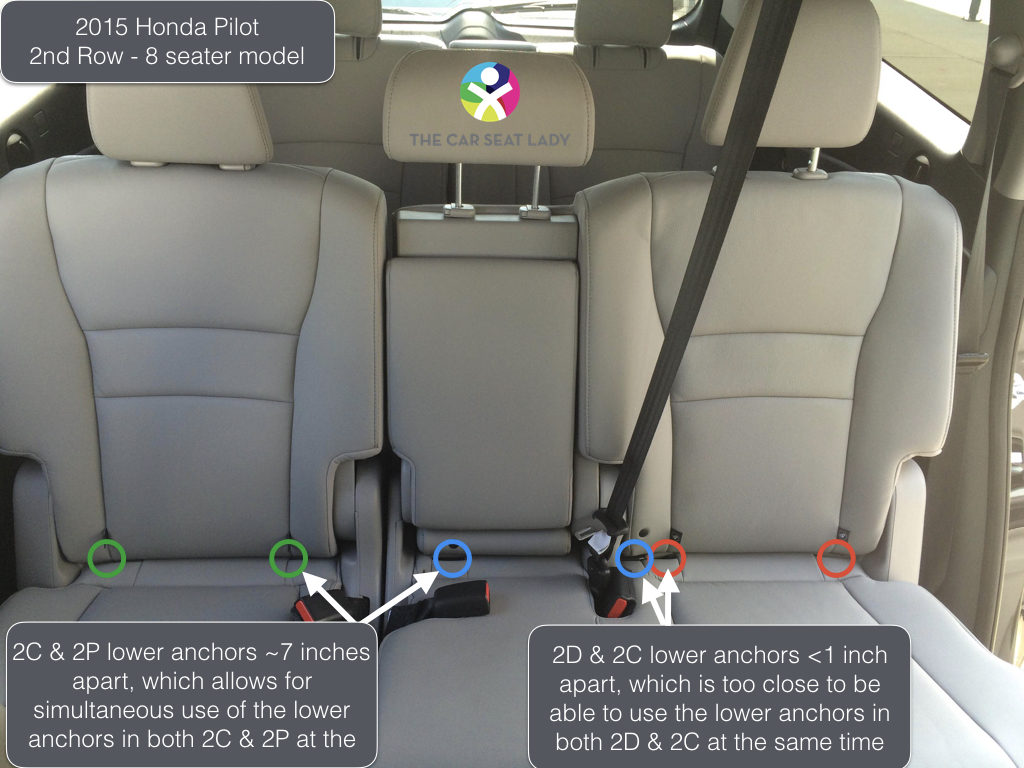
However, some vehicles with a 60/40 split do have enough space between the lower anchors on the 60 side that with some combinations of narrow car seats you can use all 3 lower anchor positions at the same time for a 3-across. The 2018 Volkswagen Atlas is a good example of a vehicle that enables 3-across with all the seats using the lower anchors.
Lower Anchors: LAs Total, R2 & R3 LAs
These columns will tell you how many seating positions in the 2nd Row and 3rd Rows respectively have lower anchors that are properly aligned with the seat belt for that seating position.
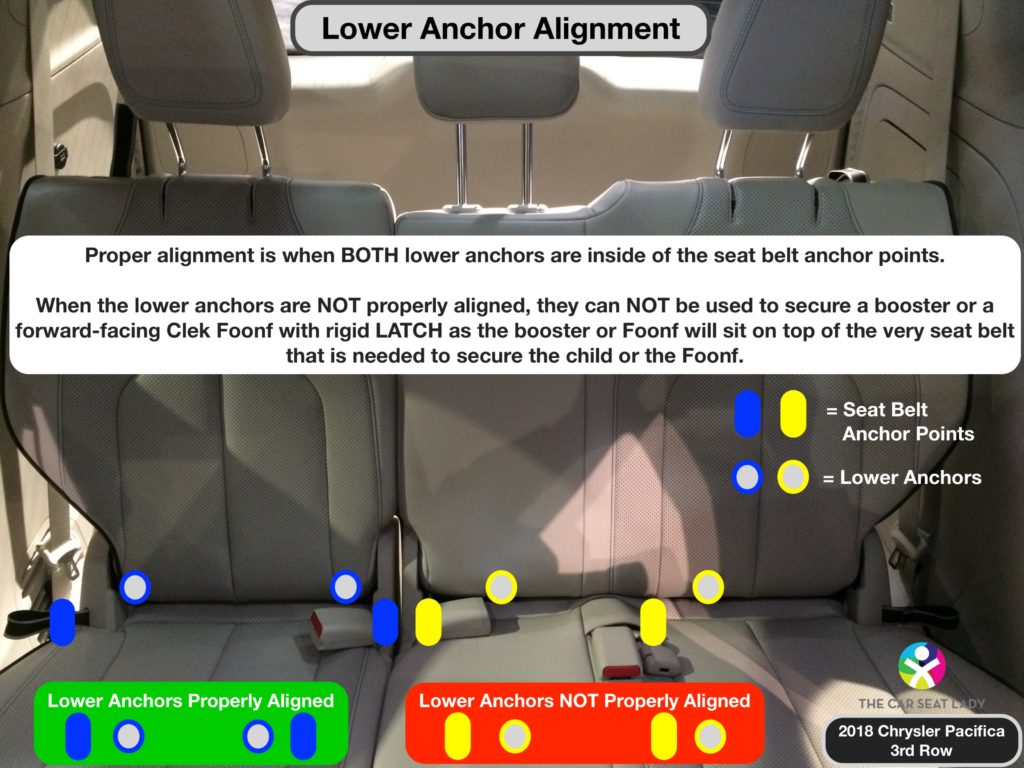
When the lower anchors are properly aligned with the seat belt, you can use these lower anchors to secure a car seat or a booster seat. If the lower anchors are not properly aligned with the seat belt, then you can not use the lower anchors to secure a booster (or a forward-facing Clek Foonf with rigid LATCH) because the booster or Foonf will sit on top of the very seat belt that you will be using to secure the child in the booster or the Foonf to the vehicle.
See the picture above of the 2018 Chyrsler Pacifica's 3rd row. The lower anchors in 3P are properly aligned - meaning they are located within the anchor points for 3P's seat belt. (Anchor points are the points where the lap belt comes out of and where the seat belt buckle is located). In contrast, the lower anchors for 3C are not properly aligned - they are not within the anchor points for 3C's seat belt. Rather, the anchor point for 3C's lap belt is located within the lower anchor area for 3C. Therefore, 3P gets counted as a lower anchor position, but 3C does not. 3C's lower anchors will get mentioned in as an "excluded LA" position.
What does it mean if there is a * next to the number in this column?
If you see a * next to the number in this column, it means that we have not counted one or more of the lower anchor positions because they were not properly aligned. You will see that we have noted which positions we have excluded.
Sometimes the vehicle added a 5th lower anchor to the row (to use to secure a car seat in the center seat) and anytime a 5th lower anchor is present, this lower anchor position is always misaligned with its seating position. Therefore, we don't include it in our count. Example: 2C in the 2012-2018 Honda CR-V.
Sometimes a vehicle manufacturer - for reasons we can not explain - decides to misalign the lower anchors for that particular position. Example: 3D in the 2019 Subaru Ascent.
What about vehicles that allow "borrowing" the innermost lower anchors to install a car seat in the center?
A few vehicles allow you to borrow the innermost lower anchors from the side seats to install a car seat in the center with the lower anchors. Because this borrowing creates a whole host of complications (not to mention it makes it such that you can't install a car seat on either side with the lower anchors) we have NOT considered the center seat as having lower anchors in these situations. We have only counted a position as having lower anchors if it has its own pair of lower anchors that are not shared with any other position. The same goes for vehicles that have 5 lower anchors where 1 lower anchor is shared between 2 seating positions. We did not count these vehicles as having lower anchors for all 3 seats - but rather for only 2 seats - since the most number of lower anchor positions you can use at once is 2 in these situations.
These columns will tell you how many seating positions have lower anchors that are properly aligned with the seat belt for that seating position and for 3-row vehicles you'll see 2 additional columns that show you how many lower anchor positions you have in the 2nd and 3rd rows respectively.

What do you mean by "properly aligned"?
See the picture above of the 2018 Chrysler Pacifica's 3rd row. The bluelower anchors in 3P are properly aligned - meaning they are located within the anchor points for 3P's seat belt. (Anchor points are the points where the lap belt comes out of and where the seat belt buckle is located). In contrast, the yellow lower anchors for 3C are not properly aligned - they are not within the anchor points for 3C's seat belt.
When the lower anchors are properly aligned with the seat belt, you can use these lower anchors to secure a car seat or a booster seat.
What's the problem with lower anchors that are NOT properly aligned?
When the lower anchors are not properly aligned with the seat belt, you can not use the lower anchors to secure a booster (or a forward-facing Clek Foonf with rigid LATCH) because the booster or Foonf will sit on top of the very seat belt that you will be using to secure the child in the booster or the Foonf to the vehicle.
In the majority of cases, these overlapping lower anchors also prevent you from having a car seat or person sit safely in the adjacent seating position as the overlap often makes it such that the car seat sits on top of the seat belt buckle for the adjacent seat. Of the few vehicles with overlapping lower anchors, it is usually only one lower anchor position that is affected. However, there are a few vehicles with supremely horrible placement for the lower anchors in two seating positions (like the .
The 2004-2018 Toyota Sienna has overlapping lower anchors for 3C. Below is what you'll see for the 2014 Sienna - note how 3C's lower anchor position is green and red to indicate that it has lower anchors, but they are overlapping with an adjacent seat (in this case, with 3D).
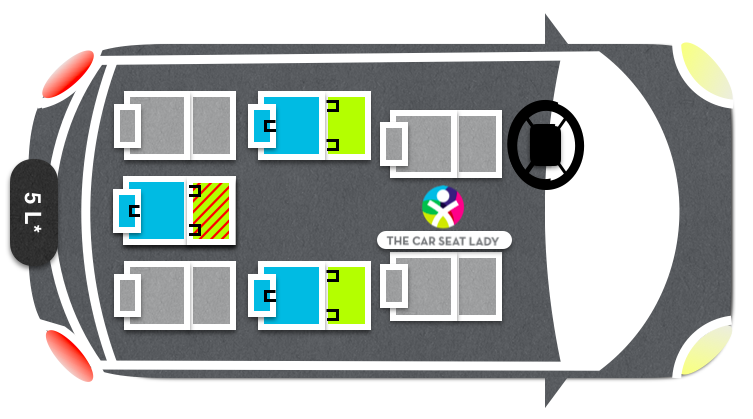
Here are pictures of what the 2014 Toyota Sienna back seat really looks like to show how overlap affects the use of the 3rd row.
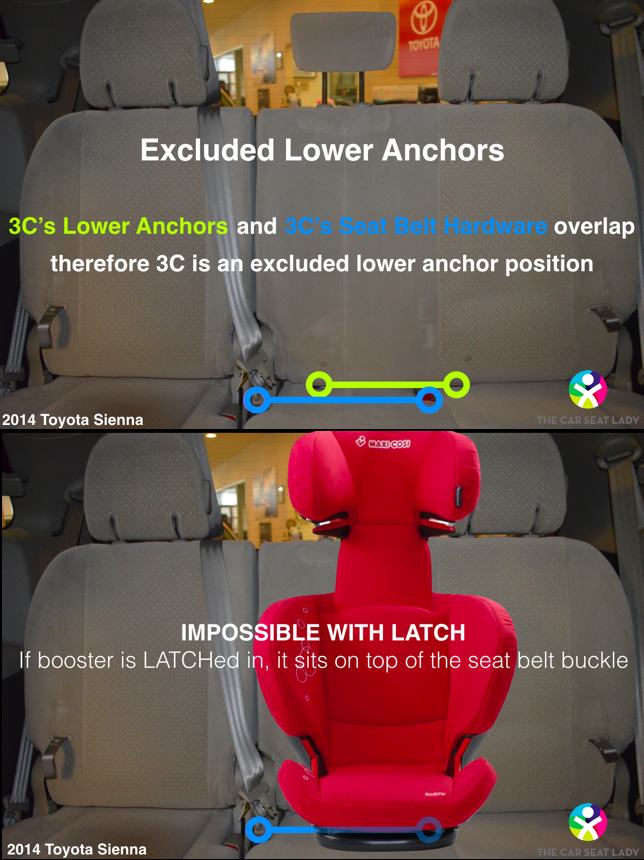
What does it mean if there is a * next to the number in this column?
If you see a * next to the number in this column, it means that we have not counted one or more of the lower anchor positions because they were not properly aligned.
Sometimes the vehicle added a 5th lower anchor to the row (to use to secure a car seat in the center seat) and anytime a 5th lower anchor is present, this lower anchor position is always misaligned with its seating position. Therefore, we don't include it in our count. Example: 2C in the 2012-2018 Honda CR-V.
Sometimes a vehicle manufacturer - for reasons we can not explain - decides to misalign the lower anchors for that particular position. Example: 3D in the 2019 Subaru Ascent.
What about vehicles that allow "borrowing" the innermost lower anchors to install a car seat in the center?
A few vehicles allow you to borrow the innermost lower anchors from the side seats to install a car seat in the center with the lower anchors. Because this borrowing creates a whole host of complications (not to mention it makes it such that you can't install a car seat on either side with the lower anchors) we have NOT considered the center seat as having lower anchors in these situations. We have only counted a position as having lower anchors if it has its own pair of lower anchors that are not shared with any other position. The same goes for vehicles that have 5 lower anchors where 1 lower anchor is shared between 2 seating positions. We did not count these vehicles as having lower anchors for all 3 seats - but rather for only 2 seats - since the most number of lower anchor positions you can use at once is 2 in these situations.
R2 & R3 LAs (only shown for 3-row vehicles)
These columns will tell you how many seating positions in the 2nd Row and 3rd Rows respectively have lower anchors that are properly aligned with the seat belt for that seating position.

When the lower anchors are properly aligned with the seat belt, you can use these lower anchors to secure a car seat or a booster seat. If the lower anchors are not properly aligned with the seat belt, then you can not use the lower anchors to secure a booster (or a forward-facing Clek Foonf with rigid LATCH) because the booster or Foonf will sit on top of the very seat belt that you will be using to secure the child in the booster or the Foonf to the vehicle.
See the picture above of the 2018 Chyrsler Pacifica's 3rd row. The lower anchors in 3P are properly aligned - meaning they are located within the anchor points for 3P's seat belt. (Anchor points are the points where the lap belt comes out of and where the seat belt buckle is located). In contrast, the lower anchors for 3C are not properly aligned - they are not within the anchor points for 3C's seat belt. Rather, the anchor point for 3C's lap belt is located within the lower anchor area for 3C. Therefore, 3P gets counted as a lower anchor position, but 3C does not. 3C's lower anchors will get mentioned in as an "excluded LA" position.
What does it mean if there is a * next to the number in this column?
If you see a * next to the number in this column, it means that we have not counted one or more of the lower anchor positions because they were not properly aligned. You will see that we have noted which positions we have excluded.
Sometimes the vehicle added a 5th lower anchor to the row (to use to secure a car seat in the center seat) and anytime a 5th lower anchor is present, this lower anchor position is always misaligned with its seating position. Therefore, we don't include it in our count. Example: 2C in the 2012-2018 Honda CR-V.
Sometimes a vehicle manufacturer - for reasons we can not explain - decides to misalign the lower anchors for that particular position. Example: 3D in the 2019 Subaru Ascent.
What about vehicles that allow "borrowing" the innermost lower anchors to install a car seat in the center?
A few vehicles allow you to borrow the innermost lower anchors from the side seats to install a car seat in the center with the lower anchors. Because this borrowing creates a whole host of complications (not to mention it makes it such that you can't install a car seat on either side with the lower anchors) we have NOT considered the center seat as having lower anchors in these situations. We have only counted a position as having lower anchors if it has its own pair of lower anchors that are not shared with any other position. The same goes for vehicles that have 5 lower anchors where 1 lower anchor is shared between 2 seating positions. We did not count these vehicles as having lower anchors for all 3 seats - but rather for only 2 seats - since the most number of lower anchor positions you can use at once is 2 in these situations.
Tethers: TAs Total, R2 & R3 TAs, Tether Pictures
These columns tell you how many tether anchors there are in the 2nd row, 3rd row, and the entire vehicle respectively.
Unlike with the lower anchors, we did not have to exclude any tether anchors as tether anchors can be slightly misaligned and still work properly (there are rules for vehicle manufacturers to follow about how misaligned a tether anchor can be).![]()
Some tether anchors are marked off with the universal symbol for a tether anchor - a boat anchor + car seat (as shown above). Other tether anchors just look like random metal bars - and many look similar to other metal bars (like cargo hooks) - but it is important to know that cargo hooks are typically not strong enough to hold a tether in a crash.
To see where exactly the tether anchor is located in your vehicle, click on the link in the CSL Page column and you'll see that we have a picture of the tether anchors - circled in green - for every minivan & 3 row SUV for the 2017 & 2018 model year (and for many older model years as well). If we don't have a picture of the tether anchors, check the vehicle's owners manual which you can download for free by going here - thecarseatlady.com/freevehiclemanuals (this is for both old and new vehicles).
R2 Seats & R3 Seats
R2 = 2nd Row
R3 = 3rd Row.
These columns tell you how many seats you have in the 2nd row and how many in the 3rd row.
Here's why you may care about this. Let's take a 7-seater vehicle. You'll always have 2 seats in front (driver & front passenger). However, the 2nd & 3rd rows can vary in a way that might make one unsuitable for your family's needs.
Let's say you want to do 3-across in the 2nd row of your new 7-seater vehicle. The pictures below show two possible options for a 7-seater vehicle. If you choose a vehicle with the layout shown on the left (2 captain's chairs in the middle row) you can't do 3-across in the 2nd row as the 2nd row only has 2 seats! To do 3-across in the 2nd row you need a vehicle that looks like the one on the right - with 3 seats in the 2nd row. You can filter in the R2 seats column so that you only see the vehicles with 3 seats in the 2nd row if this is the layout that is best for your family.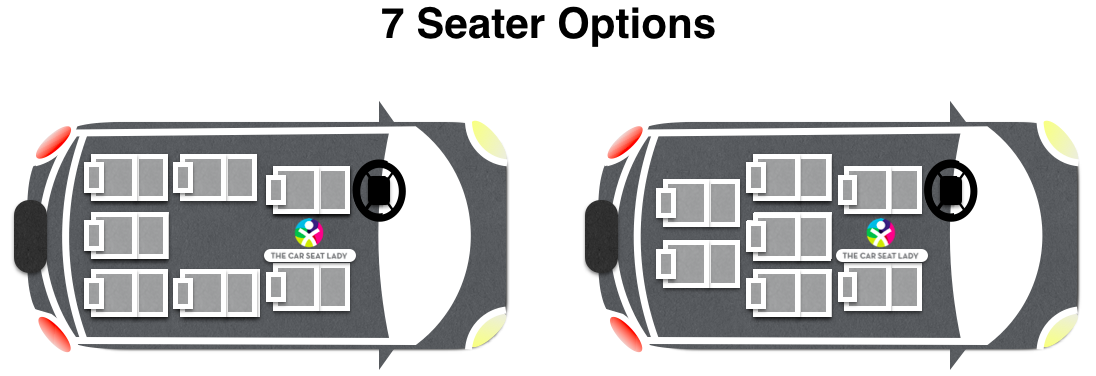
Recline
The back seats in most SUVs and minivans can be reclined. But... most people who have a vehicle with reclining seat backs don't know their vehicle has this feature! We are highlighting which vehicles have a seat back that reclines - and where the lever/handle is to adjust the recline - because we want you to use the "seat back recline trick" shown in the video below as it will help you get the car seat tighter than before, and with less effort. A tighter car seat is a safer car seat as you want the car seat and child as tightly coupled to the vehicle as possible.
https://youtu.be/LEI7ToFkRAQ?t=50s
And if you find yourself in a vehicle that has a seat back that reclines and has seat belt buckles that are rigid and pointing towards the front of the car and making it hard to get a forward-facing car seat installed securely, check out the "double seat back recline trick"
https://www.youtube.com/watch?v=lMHD8M6RHZM
Misc Pics
Accordion Sample Description
Bump at Bight
Accordion Sample Description
SBO
Accordion Sample Description
Rigid Buckles
This column is talking about the vehicle's seat belt buckles (the part with the red button... you know, the female end) and whether they are flexible or rigid.
In a nutshell, flexible is better than rigid.
Rigid buckles are often bad news for fitting multiple car seats + adults in a back seat, as since you can't move the buckle you are more likely to find the buckle stuck for an adjacent position stuck underneath a neighboring car seat or booster.
Flexible buckles are connected to the vehicle on a short stalk made out of a flexible material - usually seat belt webbing, but sometimes a coated piece of wire. Flexible buckles are much more likely to accommodate 2-together & 3-across arrangements because since the buckle has some flexibility you can often get it out of the way of a neighboring car seat or booster to be able to use all of the seats in back.
Booster in 2C
Accordion Sample Description
2C Width
Accordion Sample Description
2D-2P LA Spacing
Accordion Sample Description
Head Restraints (HRs): HR Pics, 2D/2P & 2C HR, 3D/3P & 3C HR
This column tells you more about head restraints (HRs) than you ever thought you'd want to know!
It will tell you if the head restraints are:
- Present - sadly some vehicles have no head restraints (GM has no head restraints in 2C or 3C in any of their vehicles)
- Adjustable - can the head rest move up/down for taller/shorter people
- Removable - can you take the head restraint out completely
- Tall Enough - can it support to the top of the ears of a 5'1" adult (this lets you know that a kid in a backless booster and definitely shorter adults can ride safely here)
Why should you care if a head restraint is tall enough?
A good HR can help prevent whiplash! Whiplash is the most frequently reported injury in U.S. auto insurance claims. And in 2007, the cost of claims in which neck pain was the most serious injury was about $8.8 billion, or 25 percent of the total payout for crash injuries. You should care about preventing whiplash!
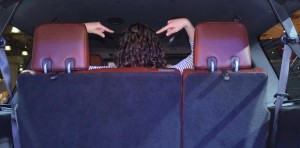
BAD: 3rd row of 2015 Ford Expedition showing lack of whiplash protection for center seat, but good head restraints for the side seats.
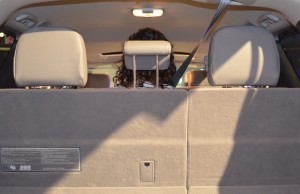
GOOD: 3rd row of 2015 Toyota Sequoia showing great head restraints for all 3 seats
Kids in rear and forward-facing car seats don't need to worry about the vehicle's HR. Kids in backless boosters (as well as some high back boosters that are not strong enough to support the child's head from going backwards), as well as older kids & adults in seat belts all need the vehicle's HR to come up to AT LEAST the top of their ears for good whiplash protection. Therefore, if a vehicle you are considering does not have an adequate HR in a particular seating position, you will want to factor in that adults & kids in backless boosters will not be able to sit there safely.
Why should you care if a head restraint is removable?
A lot of vehicle HR's tilt forward because this offers better whiplash protection for an adult - but it also interferes with the proper fit of many forward-facing car seats and high back boosters. Therefore, vehicles that have HR's that are removable will increase your chances of getting a car seat or high back booster to fit in that position because you can simply remove the HR to allow the forward-facing car seat or booster to fit well.
HR's that are fixed and non-removable - those that look like a solid chunk that simply comes up from the back of the vehicle seat - not only can interfere with car seats & high back boosters, but also can lessen the effectiveness of straight tether straps.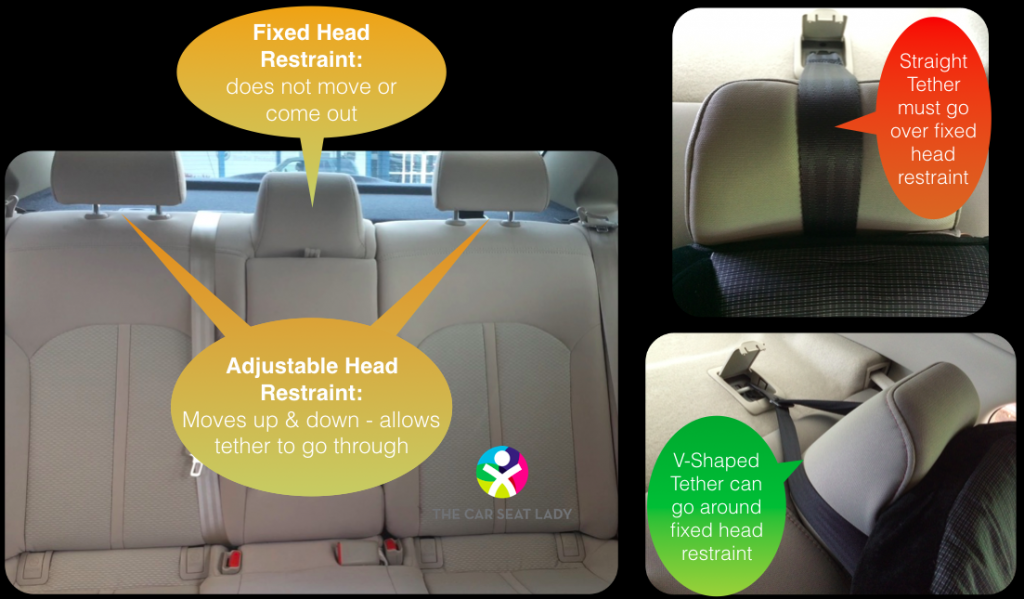 If your vehicle has a fixed, non-removable HR where you are installing a forward-facing car seat, we suggest using a car seat with a V-shaped tether strap - like found on Britax seats & the IMMI Go - as the V will go around the HR. Side impact testing research has shown that straight tethers slide off the top of these HR's, which leaves the tether loose when you most need it to be tight.
If your vehicle has a fixed, non-removable HR where you are installing a forward-facing car seat, we suggest using a car seat with a V-shaped tether strap - like found on Britax seats & the IMMI Go - as the V will go around the HR. Side impact testing research has shown that straight tethers slide off the top of these HR's, which leaves the tether loose when you most need it to be tight.
**Please always read the vehicle owner's manual as there are some vehicles with fixed head restraints that recommend routing a straight tether to the side of, rather than over, the fixed head restraint (e.g. Tesla Model X).
Notes
Accordion Sample Description
Weight
IIHS research shows that your chance of survival is significantly greater in a vehicle that weighs at least 3,000 pounds, compared to a lighter vehicle. Quite a few vehicles hover near 3,000 pounds, while others are significantly below at under 2,500 pounds. Therefore, instead of giving an exact weight for the vehicle (especially since the weight sometimes varies by a few hundred pounds depending on the trim and options you get) we have classified the vehicles as under 2.5K pounds, approximately 3K pounds, and greater than 3K pounds. We'd recommend choosing a vehicle that is greater than 3K pounds.
AWD
This column tells you if AWD is available for this vehicle. For vehicles that offer 4WD, we've indicated this as well.
Fuel Types
This column tells you which type of fuel options are available for this vehicle. The next column tells you which model years the vehicle was available as a hybrid.
Hybrid Available?
This column will tell you which model years the vehicle was available as a hybrid.
For vehicles that offer multiple hybrid options, it is possible that some of the model years in this column only refer to one of the hybrid options, not all of them.
Length, Width, Height
These measurements are given in inches.
The height may vary slightly depending on if you choose to get a roof rack added to your vehicle (this is an option on some vehicles).
The width may vary depending on whether the vehicle was measured with the side mirrors out or folded in. If you have a very tight space you need to park this car in, you'll want to double check the width for yourself.
2018 ACC
For the 2018 model year we've introduced a new column about ACC (Adaptive Cruise Control) as while all the 2018 vehicles earning a TSP or TSP+ have ACC, there are some significant differences between ACC systems that you as a driver might want to know about.
Best 2 Row Suv for Car Seats 2018
Source: https://thecarseatlady.com/vehicles/family-vehicle-buying-guide/my18/
0 Response to "Best 2 Row Suv for Car Seats 2018"
Post a Comment